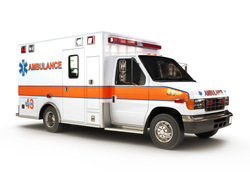Training to become a paramedic is hard, and it's nearly impossible to do all the work yourself. If you're struggling to understand all the necessary paramedic concepts, or need help with seemingly basic but hard to understand questions about becoming a paramedic, or you'd just like some additional help or reading before you take the National Registry examinations, here is some good resources for you. No need to thank us later. Informed Publishing makes several excellent pocket guides for EMS and critical care, as well as Incident Management and Firefighting. Many of their pocket guides are also available on both iOS and Android devices. For a full list, see their website. Emergency Stuff has a full list of books and materials for EMTs, Paramedics, and students, as well as a variety of prep materials for students or potential students. While the American Heart Association (AHA) publishes primarily materials for use in their courses, there are a couple of truly must-have items from them. If your course does not provide these, it is worth your while to grab the AHA's Handbook of Emergency Cardiovascular Care for Healthcare Providers. This spiral-bound flip book has all of the relevant materials and explanatory information for all of the ACLS and BLS algorithms, as well as the Acute Stroke and Acute Coronary Syndrome algorithms, and includes all of the medications referred to in the ACLS guidelines as well as several others that come in handy. Also highly recommended is a pocket reference book for medications. Brady publishing has an aptly-named Drug Guide for Paramedics, which fits in the cargo pocket of most EMS pants, and is an excellent guide to the medications used in EMS. Not every jurisdiction uses every medication in the book, so your course may not include some medications they cover, but even if you don't use them in your system you might interface with EMS systems or with ERs or other care facilities that do. Galls offers a wide range of Fire, EMS, and police clothing and equipment, as do Quick Medical and others. Many agencies that employ paid (sometimes called "career") employees will also offer either a stipend for uniforms, or will provide part or all of the official uniform through their own process. Some agencies also provide all of the materials used on a daily basis at work, and will not permit personal equipment to be used on the job (this is often due to liability). Others, however, especially in rural regions or where service is provided by volunteers, may ask their employees to provide specific equipment when the are on duty. For specific guidance, contact your agency.
 While you may well be excited to start your paramedic course, it's essential to recognize exactly what you're undertaking, in addition to how to carry out doing it. For instance, do you realize how much money paramedic classes cost? Do you know what the minimum age qualifications are for every school that you're interested in applying to? Are you mindful that some academic institutions necessitate written referrals and in-person conversations? Or that many schools or ambulance services may not be interested in your services if you have been charged or declared guilty of an unlawful act? There are a whole lot of small matters to be familiar with when it involves understanding the best ways to become a paramedic. So let's review them here. To begin, let's begin with just one important thing to know: As of January 1st, 2013, all students who are interested in obtaining national certification from the NREMT are going to now be called for to have graduated from an accredited paramedic program. To discover accredited programs, make sure to visit CAAHEP.org. With that said, as far as each school is concerned, there are a number of prerequisites students must fulfill before having the chance to be genuinely considered for any training program. And although each paramedic program is unique, the overall prerequisites are as follows: You need to be 18 years or older. You additionally need to have graduated from high school or earned your GED. You'll need a legitimate driver's license. You must already have EMT certification. That does not mean, necessarily, that you must have Emergency Medical Technician work experience (though many paramedic programs encourage students to get the job done as an EMT first before taking paramedic classes). You need to get CPR certification. You'll also possibly need to have already taken an anatomy and physiology course. If you haven't accomplished this, kindly call the school you're interested in applying to. It's fairly possible that they provide an anatomy and physiology course as part of the overall paramedic program. A few programs may also ask their prospective medics to have an Advanced Cardiac Life Support certification, too. You will also need to be able to prove that you're a healthy individual. That means you'll need to have had a physical exam, as well as provide verification of multiple immunizations. You will need to be vaccinated for illnesses like Tuberculosis, Hepatitis and Measles, Mumps and Rubella to name a few. You'll additionally need to pay for an application fee to each program you apply to, which can range in cost based on where you apply. Now that you have a better awareness of how the application process for becoming a paramedic student works, you may well be questioning tuition cost. The truth is that the cost of paramedic class varies greatly. With that said, you can count on paying anywhere between $ 1,000 and $ 10,000 for a paramedic program. Course length can be different too, as there are a vast selection of programs colleges offer. Some programs may give students weekday classes. Some other programs may provide more overall flexibility with a Saturday and Sunday class. Some schools even supply Internet paramedic training. What that usually means is that a Hybrid Paramedic Program is being provided to pupils, allowing them the chance to learn both in the school room as well as over the Internet. This is obviously extremely advantageous if you possess a day job or you are the prime caretaker in your family. With that said, paramedic courses can take anything from 6 months to about two years to complete. Depending on the program, you may graduate the training class with either a certification or an actual degree. It's definitely worth briefly pointing out what occurs once you've in fact finished a paramedic training program. Following graduation, you'll very likely want to find employment, but you need to do a couple of things first. One, it is highly recommended that you fill out an application for national certification with the NREMT. To do so, you need to pass the NREMT examinations, which is both a computer adaptive exam and a skills examination. Nevertheless, passing the national registry paramedic exams does not mean that you're qualified to work as an EMT-P on the state level. It's just a national acknowledgment. To be a candidate to work as a paramedic in your state, you'll have to apply for state licensure. This might often be as straightforward as filling out some paperwork and forwarding it to your state's EMS agency, or a lot more involved, necessitating that you to successfully pass a state test. To learn more about paramedic training, be sure to visit Paramedic Training Spot!
 Understanding how to become a paramedic can be tough, because various schools have unique requirements for their applicants. Not just that, but different states have numerous requirements for their working paramedics too, thus muddying the waters for anybody interested in learning how to become a paramedic but uncertain ways to get accurate and pertinent facts about the subject. To become a paramedic, you must first meet the criteria set by both the state and also the school of your liking. You will then need to graduate from a paramedic school, where you will take the NREMT-P exams and/or a state licensing examination. Once you formally obtain credentials through an EMS agency in your state, you’ll be capable of working as an EMT-P. If you’re interested in chasing a career as a paramedic, let us discuss three actions you ought to really think about taking. 1) Learn the Requirements Requirements vary from state to state, but typically, the eligibility demands for many paramedic schools and programs are the following: You should be 18 years of age. You will need to be a high school graduate, or possess a GED. You ought to have a valid driver’s license. You will need to have specified certifications (CPR, for example). You need to be a licensed EMT (despite the fact that real EMT experience isn’t often a necessity). From that point, the prerequisites for becoming a paramedic could vary greatly. For instance, in a state like The Lone Star State, you may be requested by a paramedic program to take the THEA test (Texas Higher Education Assessment), or perhaps an approved alternate examination like COMPASS. In some states, because you ought to be no less than 18 years old in order to enroll in a paramedic program, students will actually require an Associate’s Degree or more to become licensed to practice. 2) Apply to a Paramedic Program Figuring out which school to apply to is usually confusing, but it’s all about picking out a school which you believe gives you the ideal education and instruction. Whatever school you choose, it’s encouraged that most paramedic students give consideration to enrolling in an accredited school or program. Come January 1, 2013, all prospective paramedics who want to become Nationally Registered must have graduated from an accredited paramedic program in order to do so. 3) Graduate. Get Certified. Acquire Your License. When you finish a paramedic program, you’ll most likely want to become nationally certified from the NREMT. This necessitates passing the NREMT exams, which comprise of both a computer adaptive examination and a skills test. Passing the NREMT exams is a demonstration of meeting a national certification norm. It also gives you significantly greater flexibility in the event you move to a different state and submit an application for reciprocity (provided it’s a state that accepts the National Registry as their standard for admittance and licensure). But becoming Nationally Registered does not give you consent to work. Only the state you plan to work in can do that, and that’s through licensure. Getting licensed might sometimes be as easy as giving the state a copy of one's NREMT card. Some states, nonetheless, demand those attempting to get licensure to pass a state test. The paramedic in you is just waiting to be developed. To do so, visit http://www.paramedictrainingspot.com to learn the requirements needed by all working paramedics. You'll also be able to find accredited paramedic training programs, as well!
 Anytime you actively Google search for paramedic training programs, it can often be frustrating to see how much time it will actually take you to become a paramedic. The time period you have to spend inside a paramedic program fluctuates by school, however in the mind of a number of people, it may seem like a very long time if you want to graduate, acquire a job, and produce a healthy income. Because of this, some prospective paramedics look into ways they can fast-track themselves to becoming a trained paramedic. Looking for accelerated paramedic training courses, as well as online or free paramedic training, several potential students end up pondering suspicious schools that are often referred to as “medic mills” by a few inside the health care industry. The term “medic mill” is usually said a negative way to explain a school or course that either provides accelerated paramedic training or requires practically no prerequisites (an Anatomy and Physiology course, for instance). To put it briefly, the term “medic mills” are often tossed around by prospective pupils as schools that are untrustworthy or provide a shady shortcut to becoming an EMT-P. A “medic mill” can almost be a pejorative saying used by a few who think that a particular school doesn’t thoroughly prepare its students to become a paramedic. This is a result of a lack of thorough didactic instruction, or perhaps a poorly conceptualized clinical or field internship. But how do you avert a “medic mill?” And should you even avoid it to start with? The most important thing you should consider is that choosing a paramedic program is critical for your long-term achievement. The wrong program can leave you unprepared for both the NREMT exams, and the varied emergencies you’ll confront inside an ambulance or medical facility. With that in mind, an incredibly extensive or expensive training program doesn’t necessarily equate to a school that’s good for you. If you’re looking for which school is best, it’s always smart to focus on accredited paramedic programs. By 2013, all paramedic students will be required to have passed an accredited paramedic program should they want to be in a position to take the National Registry of Emergency Medical Technicians exams. Beyond that, however, it’s important that you know that even though accelerated programs, hybrid classes, and “medic mills” can be very helpful and hassle-free, you must know that outstanding paramedic training necessitates a great deal more than book smarts or an ability to be a superb test taker. Patient assessment is extremely important to being an excellent paramedic. And while some of this is taught, it’s by way of experience in the classroom, clinical, and field internships that best helps students hone these skills. Not all patients can easily relate their problems or health issues to a paramedic, so it's up to the working medic to adequately assess people, symptoms, and the personal injuries of your respective patients through verbal and non-verbal interaction. Those interested in fast-tracking their path to becoming a paramedic should recognize that while there are programs in place that enable you to do just that, it’s significantly more important that you become a high quality paramedic, not merely a quick one. To read more on medic mills, along with information pertaining to paramedic salary and training, be sure to visit Paramedic Training Spot!
 Paramedic classes are typically time consuming and strenuous, leaving a number of people to speculate just how much time it can take to complete paramedic school. And while there’s little question that paramedic classes take longer to complete than ones specializing in EMT training, it’s tough to give a precise amount of years it normally takes prospective pupils to finish a paramedic program mainly because it varies widely depending on the school. Still, paramedic school is usually categorized into about three parts: didactic, clinical, and field internships. Didactic education provides pupils with lectures and hands-on skills training. Clinical instruction uses in-hospital shifts to help students receive beneficial exposure to genuine patients. And a field internship places young people in the hands of a genuine paramedic unit. Throughout a field internship, students are oftentimes asked to carry out the entire scope of practice for an EMT-P, while under the watchful eye of a capable paramedic. A paramedic program is vast and tremendously comprehensive. Each school has its own required hours the program usually takes to complete. And while it’s seemingly impossible to provide a precise estimate for how long paramedic classes take, a projected guess is anywhere from 6 months to 2 yrs. But understand that this really depends upon the school’s individual program. A paramedic course will provide its pupils with a challenging curriculum that features but is not limited to Anatomy and Physiology, Emergency Pharmacology, Patient Assessment and Airway Management, Cardiology, Trauma Management, Medical Management. While participating in a paramedic course, you will also be taught invasive skills such as: External jugular cannulation, Intravenous initiation, Intra-osseous infusions, Electrocardiogram rhythm identification, Defibrillation, Chest decompression, and much more. The main reason why paramedic school typically takes longer to finish is generally dependent on the student, . Despite the fact that a number of students may join a full-time program, several other students might juggle their daily courses with their career, spouse and kids, as well as other personal hardships. Due to this fact, it’s possible that some folks may choose to consider being a part-time paramedic student. This could possibly mean that instead of usually meeting with your teacher several times a single week, you simply take your lessons on the weekend. While this really is far easier for a student, it may also mean that it may take an individual 2 whole years to conclude a course of study that otherwise may have taken merely a single year or less to complete. The price tag on taking paramedic training courses demands a brief note here, as well. Paramedic students should expect to be charged a tuition expense that reaches into the several thousand-dollar range. It’s also quite possible that you’ll have additional payments too, ones which will take care of things like training books along with clothing. In short, paramedic school could take anywhere from around six months to two years to finish since the program is developing you to ultimately save people's lives. This is the reason why it's important to possess very strong advanced life support education. To learn more about how long it takes to become a paramedic, be sure to visit http://www.paramedictrainingspot.com!
|





 RSS Feed
RSS Feed